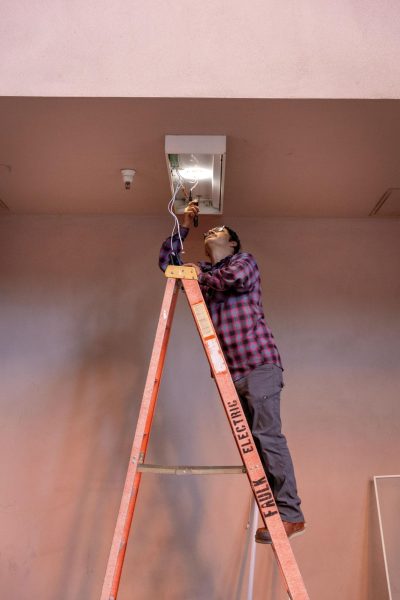If someone had gone into the Harvill Building recently, they might have noticed the building’s new lighting glow-up. As a part of an initiative organized by Students for Sustainability, a student organization that advocates for a more sustainable campus community, four University of Arizona students led the Harvill Lighting Retrofit Project, which aimed to replace the Harvill building’s older fluorescent lighting with more sustainable and efficient LED lighting.
The project was completed in January and according to the student leaders involved with the project, is predicted to save $12,897 per year in energy costs. This money saved will be used towards funding future sustainability initiatives at the university. Additionally, data collected from the team predicts that the project will result in a 42% reduction in energy consumption.
Beyond the significant energy consumption reduction and cost savings, the new LED lighting has a plethora of other benefits as well.
Studies have shown that LED-lighted classrooms increase student alertness, focus and performance and cause less eye strain. “LED lighting is a monochromatic source, which makes it better on our eyes because we don’t have to adjust to seeing a whole spectrum of light,” Camille Tinerella, one of the student leaders involved with the Harvill Retrofit Project, said.
The new LED lighting also lasts longer than fluorescent lighting.
“Fluorescent lighting has to be replaced often. That’s because if you turn fluorescent lighting on and off it actually affects the lifespan of the bulb,” Sam Gibbon, a student leader on this project, said.
Sustainable disposal practices are another added benefit of using LED lights.
“The LED lights last longer and don’t contain mercury and other toxic chemicals, so the disposal of those is much more sustainable,” Avery Berger, another student leader, said.
According to Julia Petty, a student leader for a project, the Harvill Retrofit Project has been in the making for three years, starting with a year-long auditing process of campus buildings to determine which one would be the best fit for the project.
“[Auditing] included us going into rooms, counting how many lights there were and taking the temperature of the room to understand the different aspects of the lighting and energy efficiency,” Petty said.
After narrowing down to the Harvill building, the group spent another year on the grant-writing process. Berger explained how this included preparing an almost 20-page grant application for the Campus Sustainability Fund’s annual grant and working with the Facilities Management department to secure additional grant funding from the Utility Modification Revolving Fund. In total, the team secured $103,787 in funding for this project.
The installation of the LED lighting kicked off last semester, with the Facilities Management department replacing the 927 existing light fixtures in Harvill with new, LED lighting.

Gibbon and Berger said the project also includes initiatives for educational outreach, taking the form of an expansive art banner hung in Harvill, informational flyers that remind faculty and students to turn off classroom lights after use and social media strategies to raise awareness for sustainability efforts around campus.

“I wanted to highlight the environmental impact of LED lighting, and depict how it can lead to a more beautiful and sustainable future,” Sawyer Sullivan, the artist of the banner and a member of Students for Sustainability, said. “I chose to illustrate the Sonoran Desert in an effort to focus on the direct connections between the choices we make, and the environment we live in. I wanted to design a banner that both emphasized the incredible Harvill Lighting Project, and encouraged its audience to think about and make sustainable choices in their own lives.”
When reflecting on her experiences as a part of the project, Petty noted how rewarding it was to take on a leadership role.
“Being a student and being able to manage such a large-scale project is so rewarding. It shows that any of us can get together and accomplish something really big, like actually impacting the environment or helping our university’s energy savings,” Petty said.
Gibbon said this project taught him the importance of persistence in these sorts of sustainability initiatives.
“If there’s a will there’s a way. If you’re willing to be persistent and try hard consistently, then you can achieve something of this significance,” Gibbon said.
Berger shared similar takeaways in her experience of co-leading this project.
“You might have to adapt how you go about things, but there’s plenty of room on this campus for improvements and sustainability,” Berger said. “Once you start getting your hands on it, you will find the little nitty-gritty aspects of campus and be able to work around it to create a very beneficial project.”
For students interested in initiating similar change across campus, Tinerella emphasized the power of banding together with peers.
“Students have the ability to make change. You just have to be persistent, you have to keep advocating and saying we’re going to make a change no matter what happens. That will spread like wildfire,” Tinerella said.
Follow the Daily Wildcat on Instagram and Twitter (X)










